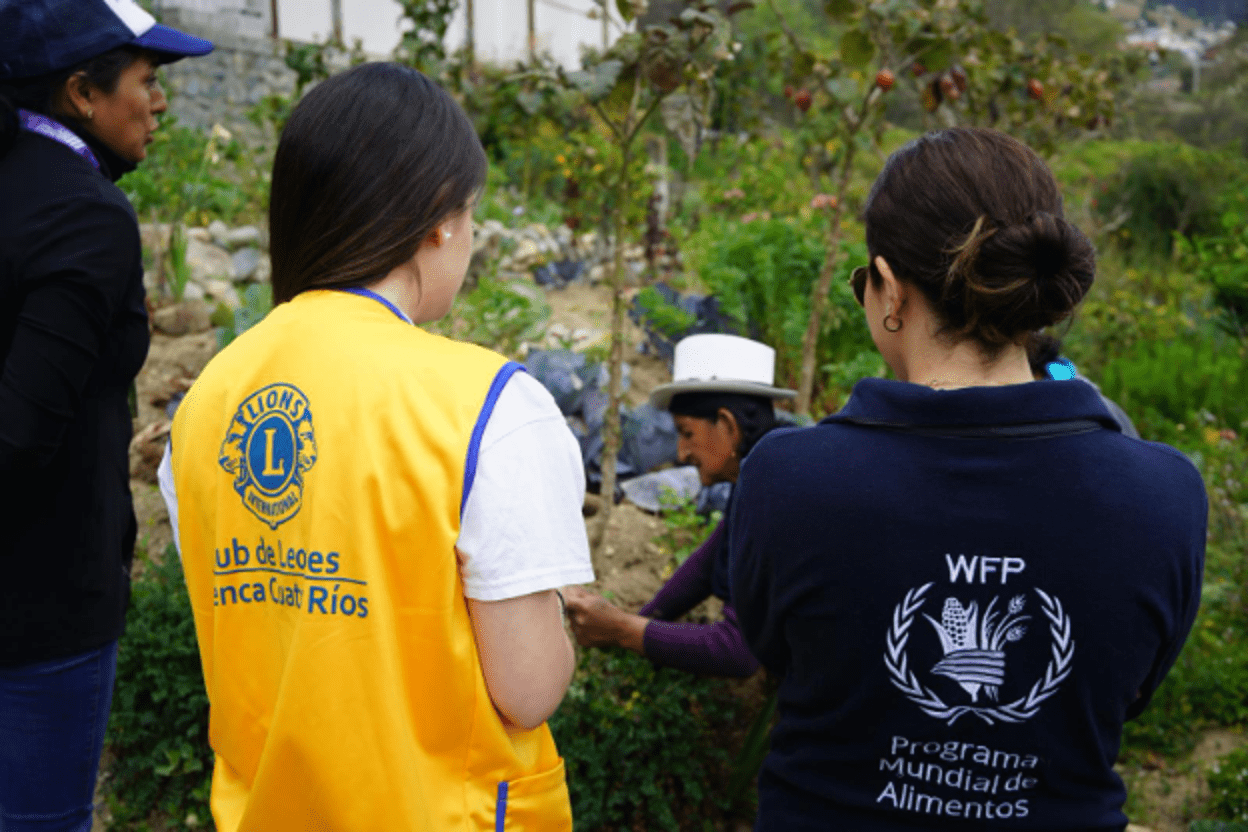As COVID-19 spreads across the globe, it brings more than the threat of disease, it also brings the threat of hunger. Currently, 135 million people suffer from severe hunger, and it’s estimated that the pandemic will double that number by year’s end. WFP is ramping up to meet the rapidly increasing need.
Technology and innovation have always been a key part of WFP’s emergency response, but now, during a global pandemic, they are perhaps more critical than ever before. That’s why it should come as no surprise that WFP tapped its Innovation Accelerator program to aid in its COVID-19 response.
The WFP Innovation Accelerator sources, supports and scales high-potential solutions to hunger worldwide. Each year, it hosts several bootcamps where technology start ups hone their innovative ideas help solve global hunger. So far, more than 60 innovations have been deployed within WFP’s operations and have been making a critical difference.
Since coronavirus hit, the Innovation Accelerator has adjusted its plans and operations, but it hasn’t slowed down. In fact, it’s now doing even more. We dialed up Bernhard Kowatsch, Head of WFP’s Innovation Accelerator, to learn more about how it’s helping WFP overcome challenges they face in this unprecedented time.
WFP USA: Thanks so much for joining us Bernhard, all the way from your home in Munich. Before we get into how Innovation Accelerator is adapting and helping, can you tell us about some of the unique obstacles COVID-19 has posed to WFP operations?
Bernhard: Sure. Right now, it’s vital that WFP maintains its global food-assistance programs. We offer a lifeline to nearly 100 million people. WFP’s top priority is to ensure that resources are in place so it can continue to get food to people who need it to survive.

This virus is posing a lot of supply chain challenges because there are restrictions on global movement – tighter border controls, commercial transport closures, etc. WFP needs to ensure that despite these obstacles, staff and supplies can reach the areas they are needed. Many areas we serve with the greatest need are also the most vulnerable to the virus, because of weak health systems or high rates of malnutrition. That’s why it’s even more critical that we are still able to reach people in these areas with the food they need. To do that, WFP needs to really prepare in advance for different scenarios.

WFP USA: What technologies are currently in place that have been helping WFP address these challenges? Are any of them ones that came out of Innovation Accelerator?
Bernhard: Within Innovation Accelerator, we support infrastructures. We look for the best ideas and innovations and startups globally. Some of the innovations we support were already developed by WFP staff, and we use Innovation Accelerator to help scale them.
One example of that is HungerMap LIVE. This technology aggregates data and sentiment analysis in near-real time. Right now, we’re using this to assess and provide information to decision makers on how the pandemic is impacting food security and dividing populations, in efforts to determine how best to reach people in need.

Another idea that came out of the Accelerator is Food ATM. We’re still working through this idea, but it could be critical for times like these – especially in places like refugee camps that are highly populated and where food distributions can be crowded. Food ATM is what you’d assume – an ATM that dispenses food instead of cash. It would enable refugees to go get food on their own when it’s safe, so they don’t have to wait for a scheduled, crowded distribution time. We were already looking carefully at potentially scaling this innovation, but the situation right now allowed us to see just how helpful it could be.

WFP USA: Those are some really great examples. How do you nurture innovations like these? Can you explain how the Innovation Accelerator program works? And how has it changed in light of COVID-19?
Bernhard: The way Innovation Accelerator works is we find interesting startups and ideas to solve hunger and host one-week bootcamps to help teams hone them. Through these bootcamps, the most promising teams receive a chance to scale and earn funding for their concept.
Obviously, because of COVID-19, we can’t host bootcamps in person right now – but we are still looking for ideas to nurture and scale globally and finding new ways to do so. Recently, for the first time ever, we organized and hosted a virtual innovation bootcamp to find digital solutions for the UN. What’s amazing is that we organized the virtual bootcamp in only five days. We saw how rapidly the situation was changing, and I’m proud of our entire team for moving quickly in response.

But I’m also really excited that it went so well. We learned that, even with teams spread across the entire world, it’s still possible for this program to work. So, for the next few months we’re planning on hosting all our programs online.
Another unique opportunity Innovation Accelerator offers is access to WFP’s network of field offices. Because WFP is all over the world we don’t have to wait until the pandemic ends to see if certain innovations are helpful. Through WFP staff in the field, we are continuing to test and implement innovative ideas coming out of our program.
WFP USA: Other than continuing to nurture and scale innovations. Is there anything else Innovation Accelerator is doing to support WFP in these times?
Bernhard: For COVID-19, WFP is actively working on preparedness for our operations. We’re making sure we have pre-positioned food and stocks in place for areas that will be potentially most affected. We’re also working on global supply chain capacity for the entire humanitarian community.

To support this, the Accelerator has been thinking of ways we can help WFP’s response right now – but we’ve also been re-imagining our response for the future in light of this pandemic. This means analyzing the critical problems that are arising and asking ourselves: What technologies could we develop in the future to solve them? We’ve been brainstorming and testing new ideas, and also presenting the problem to the tech and innovation community. We recently held a hackathon where we gave problem statements to teams who wanted to volunteer to help come up with solutions.
We are also working on a new program that we’re calling WFP-X, in which we look at some of the most out-of-the-box ideas teams have come up with. Food ATM is one example of technology we’ve been looking at through this program. Other examples are self-registration for people in refugee camps or packaging that ensures food is safe to pick up – ideas that prevent the spread of disease and keep people healthy and safe while still getting them food.

WFP USA: All of this sounds like really important work. I’m interested in learning more about the Hackathon. Can you give an example of one of the problems you posed to Hackathon groups and how they attempted to resolve it?
Bernhard: Well right now, we’re focusing on scenarios because the problem is preparedness. So, we give them a scenario and ask how, as WFP, would they respond. Say, for instance, an emergency happens in a place where you don’t have the same connectivity as you do in the U.S. This means you have to coordinate response by relying on people on the ground because you can’t videoconference or provide real-time information. How could you operate in that situation to ensure WFP is still providing people with the resources they need?
This is a more tangible example. Let’s say WFP is doing a training program for small-scale farmers in a developing country, through which we’re teaching them to sell their food and dry their crops properly to generate more income. How do we continue that program when the trainer can’t go to the community anymore – a community without internet – and train in person? It’s a challenging problem, and right now, a realistic one too, so we have to prepare for it.

WFP USA: You’ve hosted many bootcamps since your program began a few years ago. What are some of the key things you’ve learned about finding and nurturing innovative ideas that you can apply to Innovation Accelerator in the future?
Bernhard: One of the big lessons we’ve learned is that it’s actually not as important what the innovation is compared to how strong the team is. Team strength is one of the key determinants in whether or not an innovation will be successful.
This is why we came up with the bootcamp concept. The bootcamp is a high-intensity training program for teams, and I think they’re really benefiting from it. We ask them to think through a number of questions like, what’s the problem we’re trying to solve? Is the solution ready? What are you doing for marketing? And at the same time, this coaching helps us assess the teams and discover their strengths and how we can support them in areas that need development.
It’s the team that makes or breaks an innovation, and sometimes, it’s not the team with the best initial concept that will actually end up creating and scaling their idea.

WFP USA: That’s pretty interesting. In explaining these things, you get very passionate. I’m curious, how much do you love your job?
Bernhard: I am really grateful for the opportunity I have to work on innovations in a way that supports some of the most vulnerable communities worldwide. It’s a humbling experience. And yes, I love it. Because I think we are giving people the inspiration to believe that you can make a difference in the fight against hunger as a startup with innovative ideas.
And you can also make a difference simply by using the innovations startups develop. For example, through our ShareTheMeal app, people can feed families in need with a tap of their fingers. Everybody can do something to help – and I want to continue enabling that to be possible. That’s what really motivates me.
***
WFP is doing everything it can to protect the world’s most vulnerable during this time of urgent need. But we can’t do it alone. We need your support. Learn more about Innovation Accelerator, ShareTheMeal and WFP’s response to this crisis. Remember, even 50 cents can help us feed a child for a day. Every dollar counts.





